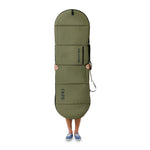
Learning the basics of surfboard cleaning goes a long way in preserving your board’s lifespan and improving its performance. Keeping your board clean not only protects your investment but also enhances your time in the water.
Whether you’re new to surfing or have years of experience, knowing how to clean a surfboard properly is essential. This guide will walk you through simple surfboard maintenance tips to keep your board in top shape.
Exposure To Elements
Saltwater, sand, and debris wear down surfboards over time. Salt is corrosive, sand creates micro-abrasions, and organic matter like seaweed can affect how your board moves through the water. Routine cleaning helps combat this wear and tear.
Regular Maintenance
Regular maintenance is key to extending your board's life. Always rinse off saltwater after surfing, check for cracks or dings, and clean off wax buildup. The cleaner your board, the better it performs.
Cleanup Prep
What you’ll need:
-
Mild detergent or surfboard cleaner
-
Soft sponge or brush
-
Clean towel
-
Freshwater
These basic tools ensure gentle but effective cleaning.
Cleaning the Surfboard
Here’s how to clean a surfboard step-by-step:
-
Rinse thoroughly with fresh water.
-
Mix detergent and water to create a gentle cleaning solution.
-
Use a sponge or brush to scrub in small, circular motions.
-
Rinse again to remove soap residue.
-
Dry the board completely with a towel.
Removing Wax Buildup
Wax can attract dirt over time. To remove it:
-
Use a wax comb or scraper
-
Apply eco-friendly wax remover
-
Wipe down with a cloth or use a wax pickle
Focus on areas with heavy buildup, like the tail and rails.
Drying and Polishing
Allow your board to air dry in a shaded, ventilated area. Once dry, use a soft cloth to polish the surface. Polishing protects against minor scratches and UV exposure.
To maintain the results, store your board in a protective surfboard bag that shields it from sunlight, dust, and impact damage.
Maintenance Tips
-
Rinse with freshwater after every session
-
Store in a cool, dry place
-
Repair small dings quickly
-
Use a quality surfboard cover when transporting your board
A reliable surfboard travel bag helps prevent unnecessary damage during transit.
Protecting Your Board With FARO
Cleaning is just the start—long-term protection is just as important. FARO Board Bags offer sustainable, high-quality surfboard bags designed to safeguard your board in storage and during travel. Whether you're heading to your local break or flying to a surf destination, FARO has you covered.
Conclusion
Learning how to clean a surfboard and sticking to a maintenance routine helps keep your board looking great and riding smoothly. Finish strong by protecting your clean board with the right gear, because a clean board deserves the best care possible.





